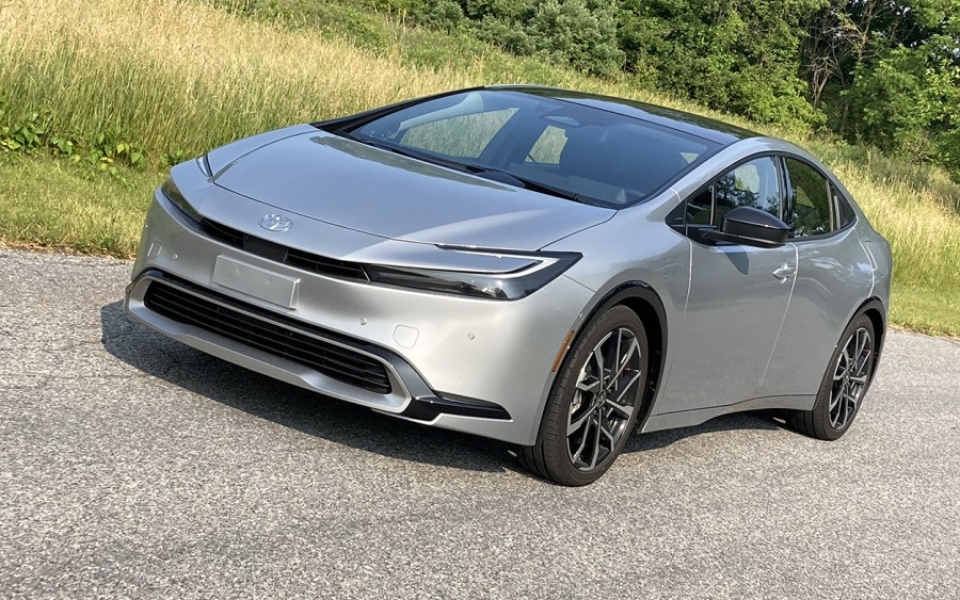
Toyota’s Prius hybrid compact sedan was the vehicle that started the hybrid technology generation that now has as few more competitors, but none equal Prius’ premier standing in the class.
And now, the 2023 Prius Prime takes this Toyota’s renowned technology to the next step by offering its Prime plug-in sedan. It offers the best of both worlds be in as an EV, or gasoline powered sedan. And this all new generation offers greater range, more power and a striking design that gives it a concept car look.
Prius Prime is offered in SE, XSE and XSE Premium that we were privileged to test.
The ‘23 Prius Prime comes with a larger lithium-ion battery that is chargeable via a plug with a receptacle on the passenger side rear of the vehicle. Prime’s battery-only electric driving range now gives 44 miles compared to the outgoing Prime that allowed 25 miles. That should be sufficient for around town grocery shopping or short commutes to a local workplace. Prime can be charged at a commercial charger such as those at Electrify America, or at your home’s 120-volt receptacle that can provide a full charge overnight.
In addition, the Prime XSE Premium we had came with a 185W solar roof panel that provides a few extra miles of driving range when parked in about 12 hours of sun. Regenerative braking also adds some extra charge as does normal driving, the given technology of a hybrid.
Prius Prime now has a 2.0-liter 4-cylinder engine that replaced the former 1.8-liter. The 2.0 in conjunction with the electric motor produces a total of 220-hp. In hybrid operation is equates to 53 city, 51-highway mpg. In electric only mode in the XSE, it’s 114 MPGe. Prime is definitely miserly in fuel consumption and in operation.
Prime had four driving modes of Custom, Sport, Normal and Eco, the latter being the most efficient and economical. In Sport, there was gobs of power. Performance was quick and robust. In electric only mode, it was super quick and quiet. There’s an EV switch on the console for electric-only mode, provided there’s sufficient charge remaining in the battery. Otherwise, the gas engine kicks in. Also on the console is a phone charging pad along with receptacles for wired charging.
While the exterior of the Prime is aerodynamic in design, its interior is equally as stylish with SoftTex heated front seats that provide nice lateral support, a heated steering wheel and heated rear seats that have tall headrests. They should be low profile like the center rest that would give better rear visibility out of the back window.
Prime’s 12.3-inch touchscreen serves apps, camera views, a premium audio, navigation and shares the dash with an all-digital gauge cluster that could be larger as it’s positioned back closer to the windshield.
In front of the gauge cluster on the steering column is a sensor that can detect if the driver’s head/eyes are distracted from looking ahead. A warning comes on telling the driver to keep eyes on the road. And it can sense a slightly turned head even while wearing sunglasses.
The infotainment display requires some time with the owner’s manual to learn all the useful features Prime’s infotainment system provides.
Insofar as HVAC controls are concern, they’re traditional and easy to use and view. The rearview camera also includes a revolving around the vehicle view that helps while checking for obstacles, obstructions, people or pets.
Back in the spacious trunk, it measures 31.5 inches deep, 35 wide and 25 high with the rear seatbacks upright. Flip the seats and cargo loading depth increases to 64 inches or 5.3 feet. And beneath the trunk floor are closed foam bins for small item storage along with a tire puncture repair kit including a bottle and air compressor.
The only demerit Prius gets is its vertical rear door handles that have been on the car since its inception as far as I can recall. They do, however, maintain the swept back design of the Prius.
Prius rides more like a midsize sedan on 19-inch Toyo tires as it is smooth and quiet. It parks easily with is tight turning radius. Prius is actually a fun and enjoyable car to drive.
Prime XSE Premium comes standard with a host of safety features such as Toyota’s Safety Sense 3.0 w/pre-collision alert, safe exit assist, blind spot monitor w/rear cross traffic alert, front cross traffic alert, lane change assist, traffic jam assist, front/rear parking assist w/automatic braking (a superb safety feature) and more.
Nicety items include satellite radio, JBL audio, Apple CarPlay, Android Auto connectivity and others.
On the options side, a digital rearview mirror ($200) gives an expansive view, solar charging roof ($610), Advanced Technology package ($1,085) with advanced park assist – meaning it can park itself, heated rear seats ($350) all of which took the base price of $39,170 to $41,415 with delivery. Considerably less than an all EV sedan and with no worries about where you can find a charging station when the battery is down.
As said, plug-in hybrid technology that the Prius Prime provides is the best of all worlds. And Toyota has been the pioneer is this technology.
Prius Prime carries a new car warranty of 3-years or 30K miles, powertrain coverage for 5/60K miles, hybrid-related components is 8/100k miles, the hybrid battery is covered for 10/150K miles plus two years or 25K miles of free maintenance.
With all this, you can’t go wrong with Toyota’s premier Prius Prime plug-in hybrid.


